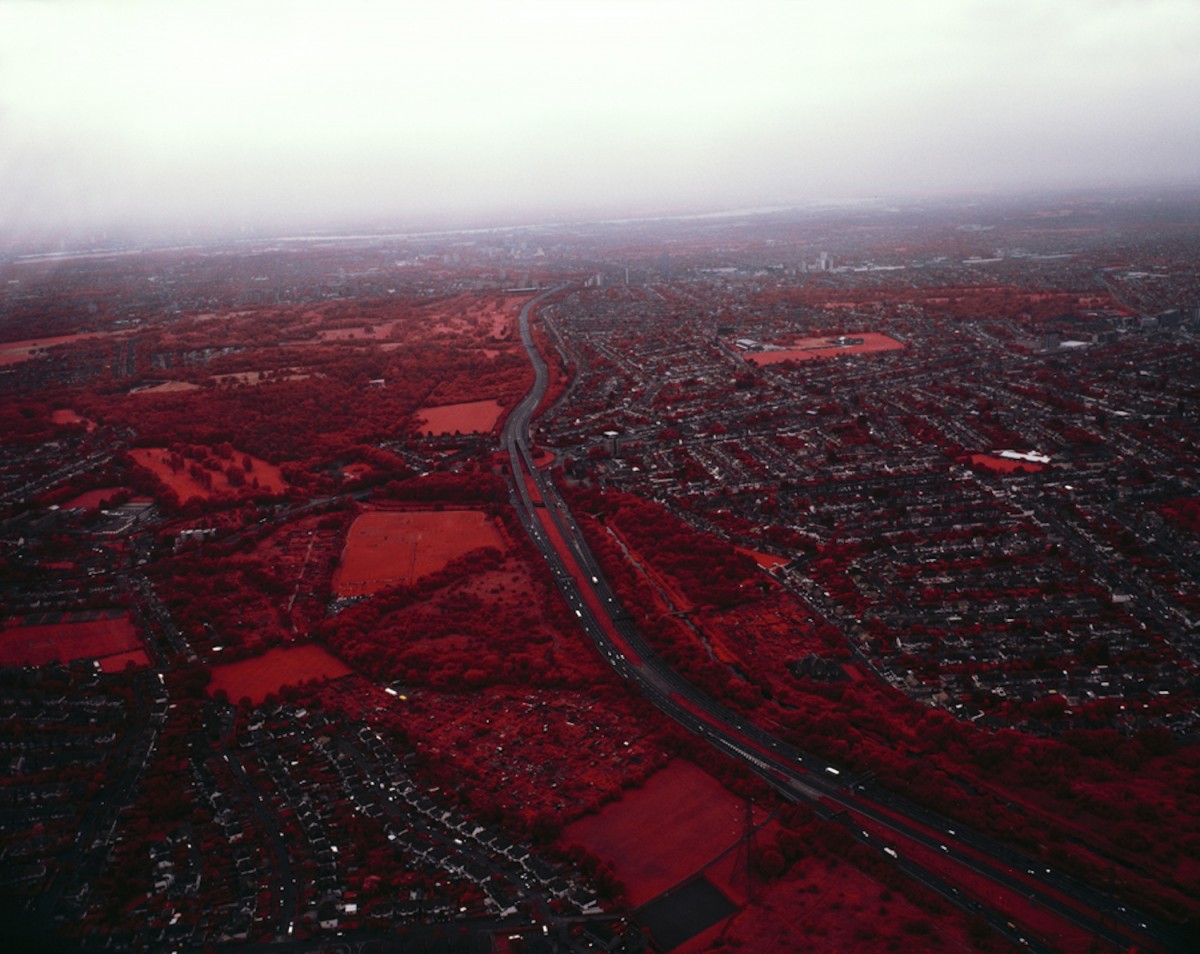Photographer Ed Thompson discusses the use of infrared photography as a tool for seeing the unseen.
In 2010 I was researching a way of documenting the haunted village of Pluckley in Kent. I started thinking about how to depict the presence of absence. While researching online, I found articles claiming that ghosts could be revealed with infrared photography. Under normal conditions we see between 400-700 nanometers, the range of light most film records. However with the correct filtration infrared film will reveal light between 750-1000 nanometers; it allows the invisible to be photographed.
After photographing The Village (2011) with 6 rolls of medium format Kodak Aerochrome film, I researched what this curious film had originally been used for. From rare books, scientific papers and the original Kodak advertisements, I devised a wider project using some of the last 36 rolls of Kodak Aerochrome in existence – pushing its boundaries to reveal the unseen.
Some of the project directly makes use of the films abilities, The Red Forest (2012) uses infrared film to document the condition of the most radioactive forest in the world and, in turn re-imagines, the Ukraine in deep Soviet burgundy, something that has become eerily prophetic since the works creation in 2012.
In The Vein (2014) forgotten medical photography techniques are used to reveal the superficial veins and subcutaneous venous system beneath the skin. In The Flood (2012) one of the original purposes of the film, the documentation of crops post-flood via aerial photography, focuses on making portraits of families who have been affected on the ground.
The Unseen is photographed with some of the last rolls of colour infrared film in existence. This finality permeates the work, the photographs are heavily dystopian, as if the film itself is aware of our mutual demise.
At the centre of the series is the idea of revealing things we cannot see, things that are beyond our perception. The notion that something is going on somewhere and that we are not aware of it. Paranoia.
The various chapters in The Unseen, as well as being things that we generally cannot perceive visually, are topics humanity tries to ignore: climate change, pollution, disease, nuclear threat, our colonial past and even death itself. It is an apocalyptic body of work, but at the same time it is a warning, like the experiments of a radical scientist trying to make humanity acknowledge uncomfortable truths.
In 2014 Public Health England, an executive agency of the U.K Department of Health, announced that pollution shortens the average Briton’s life expectancy by six months, with 1 in 12 deaths in some areas of the country partly attributable to poor air quality. Scientists from Kings College London recorded peak levels of 463 micrograms of nitrogen dioxide per cubic metre of air on Oxford Street, making it one of the most polluted areas in the world.
In The City (2014) infrared film is used for one of its original purposes, the documentation of pollution.
Infrared film is used to monitor pollution. The film will not detect thermal pollution (such as warm water entering a river). However, it may image chemicals dissolved in gaseous or aqueous effluents, since water and water vapour do not have strong infrared reflectance. Many dissolved chemicals also tend to show up dramatically in colour infrared photographs of water bodies. Certain dust, pollens, aerosols, and gases in the air also may be readily detected as well as providing a record of their presence.
Kodak Technical Data. Aerochrome Infrared.
Although there are some questionable brown streaks down the Thames, a weird plume of what looks like oil flying into the air by the O2 Arena and a thick band of yellow over central London – the film did not reveal any revelatory pollutants in London. Instead, like much of the experiments in infrared photography that make up The Unseen it revealed something else. A London corrupted.
A red weed has taken hold from Canary Wharf to the Houses of Parliament. Like the photographs of The Village this re-imagined England alludes to famous works of science-fiction, from H.G Wells’ War of the Worlds to Star Trek. This subverted un-homely London, similar to the original, asks us to revisit what we think we already know about the capital.
There has been little post-production in the photographs. The high contrast, lack of haze and colour-shift are all elements of using the infrared colour film in this context. This is a faithful depiction of London in 2014, albeit one viewed via a slightly shifted perception of the visible wavelength of light.
What has been revealed by the colour shift of the infrared film is just how red, or rather how green, London appears to be from above. Statistically London is the greenest city of its size in the world. Its green space covers almost 40 per cent of greater London – some 173 square km. It is interesting to consider this duality when looking at the work, a city that is polluted and green. This is the nature of many future cities, places where great advances will be made at the cost of great sacrifices.
As the series progresses the photographs become darker and less technically perfect. Each successive roll of dead-stock film becomes more unstable as the months pass, which in turn makes it harder to control. By the end of the series, a hellish neo-futurist spire with jagged edges thrusts out of an over-exposed landscape. The Shard.
By 2050 an estimated 66% of humanity will live in urban areas. It is imperative that future cities are habitable for everyone, both environmentally and economically. Eventually we will all live in the city.
The Unseen is currently being exhibited at Four Corners Gallery in London until the 18th April 2015.
During the course of the exhibition an affordable edition of 10 x 12 inch prints will be available from the gallery and online.


